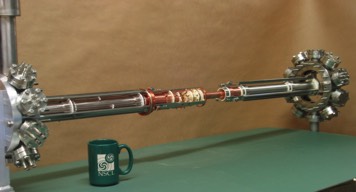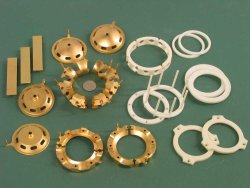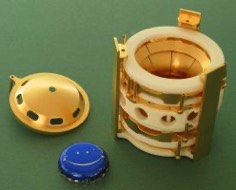
Our TOF-ICR Penning trap mass spectrometer uses a 9.4T magnet, manufactured by Cryomagnetics, which is actively shielded and compensated against ambient fields. The large gray cylinder in the photograph is the outer vacuum jacket of the magnet system. The magnet has a 5" room-temperature bore in which the Penning trap, with associated injection and ejection optics, is installed. The vacuum chamber at the end of the magnet bore contains various detector systems (a channeltron, MCP in Daly configuration, and a Si detector).
On the right is a photo of the Penning trap assembly with the associated injection and ejection optics. In this photo, the ions enter from the left and exit out the right. The first copper section in the photo below is the injector, the gold section in the middle is the Penning trap, and the last copper section is where the ions are ejected. After the ions are ejected from the trap, they strike one of the detectors mentioned above so that a time-of-flight (or activity) measurement can be taken.



The Penning trap is shown in the above photos, disassembled and assembled. The hyperbolic trap is made of two end caps and a ring electrode. Note the hole in the end cap electrodes to allow ions to be injected and ejected. The ring electrode is eight-fold segmented to permit dipole, quadrupole, and octupole excitations. Correction electrodes compensate for field imperfections. The pieces were manufactured to be as thin as possible to minimize magnetic field perturbations. The electrodes are also coated in gold to reduce electric field imperfections due to patch effects. A copper jacket (not shown) can be installed around the Penning trap for use in cryogenically cooling trap system with circulating liquid nitrogen.